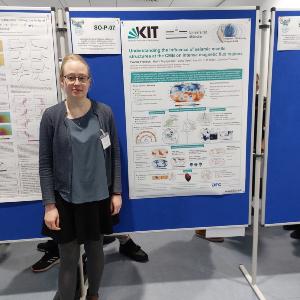Konferenzauftakt: DeepDyn auf der DGG Jahrestagung
27.03.2024
Tief unten in der Erde, an der Grenze zwischen Erdmantel und Erdkern, liegen besondere Strukturen verborgen.
27.03.2024
Tief unten in der Erde, an der Grenze zwischen Erdmantel und Erdkern, liegen besondere Strukturen verborgen.

© Yvonne Fröhlich
Tief unten in der Erde, an der Grenze zwischen Erdmantel und Erdkern, liegen besondere Strukturen verborgen.
Yvonne Fröhlich, Doktorandin am KIT in Karlsruhe, hat das Seismologie-Projekt innerhalb von DeepDyn auf der diesjährigen DGG Jahrestagung in Jena vorgestellt.
Understanding the influence of seismic mantle structures at the core-mantle boundary on intense magnetic flux regions, so der Titel, untersucht die Zonen intensiven magnetischen Flusses näher, welche meist als zueinander gehörige Paare in höheren geographischen Breiten auftreten. Diese sogenannten high latitude flux lobes befinden sich sehr stabil an bestimmten Orten, wie das kanadische Paar (Kanada - Antarktis) und sibirische Paar (Sibirien - Südindischer Ozean) - trotz eines sich fortwährend änderndes Magnetfeldes um diese Regionen herum.
Schon seit etwa 60 Jahren wird angenommen, dass Strukturen tief unten in der Erde das Erdmagnetfeld beeinflussen. Mithilfe von Bildern aus seismischen Untersuchungen wollen die Forschungsgruppen von Prof. Joachim Ritter aus Karlsruhe und Prof. Christine Thomas aus Münster diese Strukturen zwischen Erdkern und Erdmantel erforschen und kartieren. Aufzeichnungen starker Erdbeben lassen hier einen Blick ins Innere der Erde zu und ermöglichen so die Ausdehnung und chemische Zusammensetzung dieser Regionen abzuschätzen.
Gemeinsam gehen Yvonne Fröhlich, Fiona Dorn und Muhammad Dillah (Karlsruhe) sowie Harini Thiyagarajan und Lena Tölle (Münster) der Frage nach, wie gut Wärme und elektrische Energie im Grenzbereich zwischen Erdmantel und Erdkern geleitet werden können. Dies hilft dem Team den Einfluss von mineralogischen, richtungsabhängigen Kristallstrukturen und unterschiedlichen Temperaturen tief unten in der Erde auf die Bildung von Zonen hohen magnetischen Flusses an der Erdoberfläche zu untersuchen.
Diese Informationen fließen dann wiederum in Computersimulationen des Geodynamos ein, welche andere Teilprojekte des Forschungsverbundes entwickeln.
Eine wissenschaftliche Zusammenfassung des Posters von Yvonne findet sich im DGG 2024 Tagungsband auf den Seiten 181-182.
SO-P-07
Y. Fröhlich1, H. Thiyagarajan2, L. Tölle2, J. R. R. Ritter1, C. Thomas2
1Karlsruhe Institute of Technology, Geophysical Institute, Karlsruhe, 2University of Münster, Institute of Geophysics, Münster
Within the Priority Program 2404 “Reconstructing the Deep Dynamics of Planet Earth over Geologic Time” (DeepDyn) we investigate possible seismic signatures at magnetic highlatitude flux lobes (HLFL). The focus is on four target regions on the northern hemisphere: Siberia, Canada, North Atlantic and Indonesia. While Siberia and Canada show the HLFL, the North Atlantic should be the location of a third postulated flux lobe, but this area shows no high-flux signal in the magnetic field. The region beneath Indonesia and the Indian Ocean is characterized by an area of high magnetic flux that changes direction and moves westwards over time. Our aim is to understand whether mineralogy and seismic structure (i.e., thermal constraints) could be responsible for the different magnetic signatures at the core mantel boundary (CMB). This is done by combining two approaches: seismic anisotropy and seismic reflections near the CMB. To study anisotropy, we measure shear wave splitting of SKS, SKKS, and PKS phases as well as of S and ScS phases. Thereby, we determine the splitting parameters, the fast polarization direction ϕ and the delay time δt as well as the splitting intensity SI. Especially, we search for phase pair discrepancies, e.g., between SKS and SKKS phases, as they are a clear indication for a lowermost mantle contribution to the anisotropy. Based on our shear wave splitting measurements, we will derive structural and mineralogical anisotropy models using the MATLAB Seismic Anisotropy Toolbox (Walker and Wookey 2012). To test these models, we simulate synthetic seismograms using AxiSEM3D (Leng et al. 2016, 2019). Besides comparing synthetic and observed seismograms, we plan to measure the shear wave splitting of the synthetic phases and compare splitting parameters and splitting intensity to the observed values. The second approach uses seismic reflections (P and S waves) from the D” discontinuity, located 300 km above the CMB, and measures their arrival time, slowness, polarity and waveform, using array analysis. We aim to cover the regions with a number of crossing paths, for verification and also for determining whether anisotropy is present (Pisconti et al., 2022). Especially the polarity of the reflected waves, when taken together with the splitting analysis, can help to find the mineralogy that leads to the observed structures near the CMB, which in turn will help to understand the influence of the mantle on core dynamics.